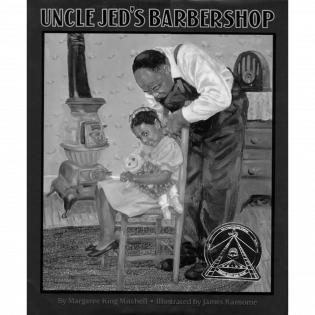Uncle Jed's Barbershop Literature Guide
Have you ever known someone who was willing to give up a great personal opportunity to help someone else? We all make choices about helping others that may interfere with our own plans. The thing we give up is an opportunity cost. Some opportunity costs are higher than others. Uncle Jed is a model of a loving, supporting family member. His sacrifice for his niece will touch your heart. When he finally realizes his dream years later, his niece is there with him, as a loving, supportive family member. Uncle Jed's actions highlight what it means to be loving and supporting in a family and in a community.
Before Reading
ASK: Do you have a favorite aunt or uncle? Why is he or she a favorite? Your family includes aunts, uncles, cousins, and grandparents. What do family members do for each other?
SHOW: Look at the cover of the book and talk about what is pictured. What do you notice? Think about how the people on the cover feel about each other.
CONNECT: We are going to read a story about an African American family that lived during the 1930s and how they helped and cared for each other. What are some ways your family helps and cares for each other?
During Reading
ASK: What did Uncle Jed give up (opportunity cost) when he gave the money to pay for Sarah Jean's operation? Was it in Uncle Jed's best interest to help? How did he feel about giving the money? How was Uncle Jed a philanthropist (someone who gives time, talent, or treasure for the common good) to his customers during the Depression?
SHOW: What do you notice about the art style and colors in the book? Look at and talk about the feelings shown in the faces.
CONNECT: It is expensive to start a business. Uncle Jed was a good barber, but his dream of having a shop of his own was very expensive. What might be some of the costs associated with starting a business?
After Reading
ASK: How did Uncle Jed help his community? How did the community support Uncle Jed? Do people in the community care about each other? How can you tell? How much (time, talent, or treasure) would you be willing to give for a family member that really needed help? How much would they be willing to give for you?
SHOW: Compare the picture of Sarah Jean in the barber chair as a little girl to the picture of her in the barber chair as a grown woman. Talk about all the differences in the pictures.
CONNECT: Uncle Jed shows us the importance of making choices for the common good. He also demonstrates the importance of persistence. He doesn’t give up even when he has many setbacks. What choices do we (as individuals or as a family) make for the common good? When is it important to keep trying even when it gets hard?
Activities
- Think of ways you can be a philanthropist in your family or community. Make a list or draw pictures of different ways you can give or share your time, your talent, and your treasure.
- Time: What can you do for the common good by spending time on something (volunteering)?
- Talent: What are you good at that you can teach or share with others?
- Treasure: What do you have (money, property, items) that you can give to help someone in need?
- Draw a picture of each of your family members helping and caring for each other.
